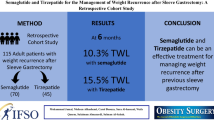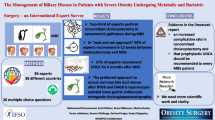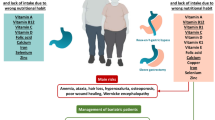Abstract
Background
Before bariatric surgery (BS), moderate weight loss, left hepatic lobe volume reduction, and micronutrient deficiency (MD) identification and correction are desirable.
Objectives
The objective of this study was to assess the safety and the effectiveness of a 4-week preoperative ketogenic micronutrient-enriched diet (KMED) in reducing body weight (BW), left hepatic lobe volume, and correcting MD in patients scheduled for BS.
Materials and Methods
In this prospective pilot study, a cohort of morbidly obese patients (n = 27, 17 females, 10 males) with a mean body mass index (BMI) of 45.2 kg/m2 scheduled for BS underwent a 4-week preoperative KMED. Their BW, BMI, fat mass (FM), fat-free mass (FFM), resting metabolic rate (RMR), left hepatic lobe volume, micronutrient status, and biochemical and metabolic patterns were measured before and after the 4-week KMED. Patient compliance was assessed by validated questionnaires (3-day estimated food records and 72-h recall). Qualitative methods (5-point Likert questionnaire) were used to measure diet acceptability and side effects.
Results
All patients completed the study. We observed highly significant decreases in BW (− 10.3%, p < 0.001, in males; − 8.2%, p < 0.001, in females), left hepatic lobe volume (− 19.8%, p < 0.001), and an amelioration of patient micronutrient status. All patients showed a high frequency of acceptability and compliance in following the diet. No adverse side effect was reported.
Conclusion
This study demonstrates that a 4-week preoperative KMED is safe and effective in reducing BW, left hepatic lobe volume, and correcting MD in obese patients scheduled for BS.





Similar content being viewed by others
References
Buchwald H, Estok R, Fahrbach K, et al. Weight and type 2 diabetes after bariatric surgery: systematic review and meta-analysis. Am J Med. 2009;122(3):248–56.
Sjöström L, Peltonen M, Jacobson P, et al. Bariatric surgery and long-term cardiovascular events. JAMA. 2012;307(1):56–65.
Schauer PR, Bhatt DL, Kirwan JP, et al. Bariatric surgery versus intensive medical therapy for diabetes—3-year outcomes. N Engl J Med. 2014;370(21):2002–13.
Sundbom M. Laparoscopic revolution in bariatric surgery. World J Gastroenterol. 2014;20(41):15135–43.
Iannelli A, Schneck AS, Hébuterne X, et al. Gastric pouch resizing for roux-en-Y gastric bypass failure in patients with a dilated pouch. Surg Obes Relat Dis. 2013;9(2):260–7.
Colles SL, Dixon JB, Marks P, et al. Preoperative weight loss with a very-low-energy diet: quantitation of changes in liver and abdominal fat by serial imaging. Am J Clin Nutr. 2006;84(2):304–11.
Parrott J, Frank L, Rabena R, et al. American Society for Metabolic and Bariatric Surgery Integrated Health Nutritional Guidelines for the surgical weight loss patient 2016 update: micronutrients. Surg Obes Relat Dis. 2017;13(5):727–41.
Iannelli A, Martini F, Schneck AS, et al. Pre-operative 4-week supplementation with omega-3 polyunsaturated fatty acid reduces liver volume and facilitates bariatric surgery in morbidly obese patients. Obes Surg. 2013;23(11):1761–5.
Ben-Porat T, Elazary R, Yuval JB, et al. Nutritional deficiencies after sleeve gastrectomy: can they be predicted preoperatively? Surg Obes Relat Dis. 2015;11(5):1029–36.
Schiavo L, Sans A, Scalera G, et al. Why Preoperative Weight Loss in Preparation for Bariatric Surgery Is Important. Obes Surg. 2016;26(11):2790–2.
Schiavo L, Scalera G, Sergio R, et al. Clinical impact of Mediterranean enriched-protein diet on liver size, visceral fat, fat mass, and fat-free mass in patients undergoing sleeve gastrectomy. Surg Obes Relat Dis. 2015;11(5):1164–70.
Ross LJ, Wallin S, Osland EJ, et al. Commercial Very Low Energy Meal Replacements for Preoperative Weight Loss in Obese Patients: a Systematic Review. Obes Surg. 2016;26(6):1343–51.
Leonetti F, Campanile FC, Coccia F, et al. Very low-carbohydrate ketogenic diet before bariatric surgery: prospective evaluation of a sequential diet. Obes Surg. 2015;25(1):64–71.
Schiavo L, Scalera G, Pilone V, De Sena G, Capuozzo V, Barbarisi A. Micronutrient deficiencies in patients candidate for bariatric surgery: a prospective, preoperative trial of screening, diagnosis, and treatment. Int J Vitam Nutr Res. 2016;1–8. https://doi.org/10.1024/0300-9831/a000282.
Fried M, Yumuk V, Oppert JM, et al. Interdisciplinary European guidelines on metabolic and bariatric surgery. Obes Surg. 2014;24(1):42–55.
Hsu CY, Bansal N. Measured GFR as "gold standard"--all that glitters is not gold? Clin J Am Soc Nephrol. 2011;6(8):1813–4.
Smith Jr JC, Butrimovitz GP, Purdy WC. Direct measurement of zinc in plasma by atomic adsorption spectroscopy. Clin Chem. 1979;25(8):1487–91.
Fris RJ. Preoperative low energy diet diminishes liver size. Obes Surg. 2004;14(9):1165–70.
Schiavo L, Scalera G, Pilone V, et al. Fat mass, fat-free mass, and resting metabolic rate in weight-stable sleeve gastrectomy patients compared with weight-stable nonoperated patients. Surg Obes Relat Dis. 2017;13(10):1692–9.
Schiavo L, Scalera G, Pilone V, et al. Preservation of fat-free mass after bariatric surgery: our point of view. Obes Surg. 2017;27(4):1071–3.
Schiavo L, Scalera G, Pilone V, et al. A comparative study examining the impact of a protein-enriched vs normal protein postoperative diet on body composition and resting metabolic rate in obese patients after sleeve gastrectomy. Obes Surg. 2017;27(4):881–8.
Haugen HA, Chan LN, Li F. Indirect calorimetry: a practical guide for clinicians. Nutr Clin Pract. 2007;22(4):377–88.
Nieman DC, Austin MD, Benezra L, et al. Validation of Cosmed's FitMate in measuring oxygen consumption and estimating resting metabolic rate. Res Sports Med. 2006;14(2):89–96.
Haugen HA, Melanson EL, Tran ZV, et al. Variability of measured resting metabolic rate. Am J Clin Nutr. 2003;78(6):1141–5.
Compher C, Frankenfield D, Keim N, et al. Evidence analysis working group. Best practice methods to apply to measurement of resting metabolic rate in adults: a systematic review. J Am Diet Assoc. 2006;106(6):881–903.
Schiavo L, Favrè G, Pilone V, Rossetti G, de Sena G, Iannelli A, Barbarisi A Low-purine diet is more effective than normal-purine diet in reducing the risk of gouty attacks after sleeve gastrectomy in patients suffering of gout before surgery: a retrospective study. Obes Surg. 2017. https://doi.org/10.1007/s11695-017-2984-z
Paoli A, Rubini A, Volek JS, et al. Beyond weight loss: a review of the therapeutic uses of very-low-carbohydrate (ketogenic) diets. Eur J Clin Nutr. 2013;67(8):789–96.
Veech RL. The therapeutic implications of ketone bodies: the effects of ketone bodies in pathological conditions: ketosis, ketogenic diet, redox states, insulin resistance, and mitochondrial metabolism. Prostaglandins Leukot Essent Fatty Acids. 2004;70(3):309–19.
Cappello G, Franceschelli A, Cappello A, et al. Weight loss and body composition changes following three sequential cycles of ketogenic enteral nutrition. J Res Med Sci. 2012;17(12):1114–8.
Lewis MC, Phillips ML, Slavotinek JP, et al. Change in liver size and fat content after treatment with Optifast very low-calorie diet. Obes Surg. 2006;16(6):697–701.
Edholm D, Kullberg J, Haenni A, et al. Preoperative 4-week low-calorie diet reduces liver volume and intrahepatic fat, and facilitates laparoscopic gastric bypass in morbidly obese. Obes Surg. 2011;21(3):345–50.
Collins J, McCloskey C, Titchner R, et al. Preoperative weight loss in high-risk super obese bariatric patients: a computed tomography-based analysis. Surg Obes Relat Dis. 2011;7(4):480–5.
Brody F, Vaziri K, Garey C, et al. Preoperative liver reduction utilizing a novel nutritional supplement. J Laparoendosc Adv Surg Tech A. 2011;21(6):491–5.
Frutos MD, Morales MD, Luján J, et al. Intragastric balloon reduces liver volume in super-obese patients, facilitating subsequent laparoscopic gastric bypass. Obes Surg. 2007;17(2):150–4.
Aberle J, Freier A, Busch P, et al. Treatment with Sibutramine prior to roux-en-T gastric bypass leads to an improvement of metabolic parameters and to a reduction of liver size and operative time. Obes Surg. 2009;19(11):1504–7.
González-Pérez J, Sánchez-Leenheer S, Delgado AR, et al. Clinical impact of a 6-week preoperative very low-calorie diet on body weight and liver size in morbidly obese patients. Obes Surg. 2013;23(10):1624–31.
Kimmons JE, Blanck HM, Tohil BC, et al. Association between body mass index and the prevalence of low micronutrient levels among US adults. Med Gen Med. 2006;19:8–59.
Flancbaum L, Belsley S, Drake V, et al. Preoperative nutritional status of patients undergoing roux-en-Y gastric bypass for morbid obesity. J Gastrointest Surg. 2006;10:1033–7.
Peterson LA, Cheskin LJ, Furtado M, et al. Malnutrition in Bariatric Surgery Candidates: Multiple Micronutrient Deficiencies Prior to Surgery. Obes Surg. 2016;26(4):833–8.
Thibault R, Huber O, Azagury DE, et al. Twelve key nutritional issues in bariatric surgery. Clin Nutr. 2016;35(1):12–7.
Pierpont YN, Dinh TP, Salas, et al. Obesity and surgical wound healing: a current review. ISRN Obes. 2014;2014:638936.
Arnold M, Barbul A. Nutrition and wound healing. Plast Reconstr Surg. 2006;117:42–58.
Author information
Authors and Affiliations
Corresponding author
Ethics declarations
Conflict of Interest
The Ketocompleat was kindly provided by MVMedical Solutions.
AI and LS received travel grants and consulting fees from MVMedical Solutions.
Informed Consent
Written informed consent was obtained for each individual participant included in the study.
Ethical Approval
All procedures performed in this study were in accordance with the ethical standards of the institutional and/or national research committee and with the 1964 Declaration of Helsinki and its later amendments.
Rights and permissions
About this article
Cite this article
Schiavo, L., Pilone, V., Rossetti, G. et al. A 4-Week Preoperative Ketogenic Micronutrient-Enriched Diet Is Effective in Reducing Body Weight, Left Hepatic Lobe Volume, and Micronutrient Deficiencies in Patients Undergoing Bariatric Surgery: a Prospective Pilot Study. OBES SURG 28, 2215–2224 (2018). https://doi.org/10.1007/s11695-018-3145-8
Published:
Issue Date:
DOI: https://doi.org/10.1007/s11695-018-3145-8




